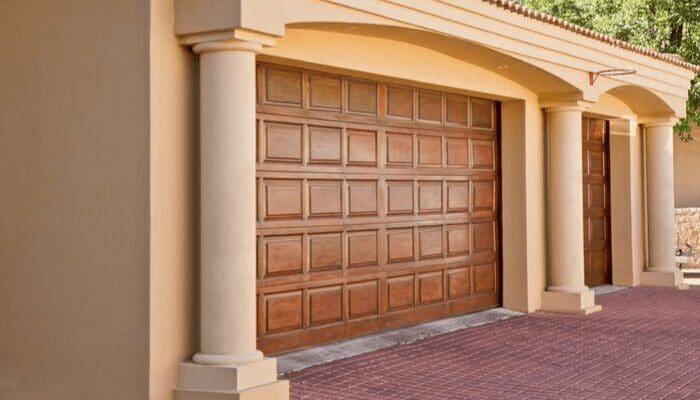Does a Finished Garage Add Value or Is It Just a ‘Nice to Have’?
- Published on
- 5 min read
-
 Christine Bartsch Contributing AuthorClose
Christine Bartsch Contributing AuthorClose Christine Bartsch Contributing Author
Christine Bartsch Contributing AuthorFormer art and design instructor Christine Bartsch holds an MFA in creative writing from Spalding University. Launching her writing career in 2007, Christine has crafted interior design content for companies including USA Today and Houzz.
Compared to the rest of the house, your grungy, dusty, unfinished garage looks like a catch-all junk room that the construction crew abandoned mid-build.
It. Needs. Help.
But does it pay to outright finish your garage to match the rest of the house if you’re planning to sell the place?
The truth is while real estate pros say a clean, well-organized garage will impress buyers, you shouldn’t expect to get much out of this project from a resale value standpoint—unless you attract that car buff buyer who needs a special place to store their toys.
Here we’ll cover the most common questions about the difference between a finished vs. converted garage, plus alternative garage projects that boost your home’s marketability more than a full refinish.

What is a “finished” garage anyway?
First, let’s define what the term “finished garage” means:
“A finished garage doesn’t have open and exposed beams, it’s drywalled, and in some cases the walls are textured and painted,” explains Ryan McKee, an experience Los Angeles-based agent who’s recently sold properties with finished garages.
“For some people there’s an extended definition for a finished garage that means it’s finished to a livable condition to use as an extra bedroom, a bonus room, or as a rentable space. However, most call those converted garages.”
Finished vs. converted garage: How each impacts your home’s value
Right off the bat you need to know that converting your garage into additional living space (meaning you’ve taken out the garage door) is never a good idea when you’re planning to sell. A house without a functional garage will decrease in value and make it harder to sell.
“I’ve actually had a recent experience on a converted garage where it detracted from the value of the house,” recalls McKee.
“The seller had converted the garage into a large bonus room, but it didn’t have an attached bathroom and its location within the house was awkward. In order to sell the house, he had to convert it back to a functional garage.”
A finished garage won’t hurt your home’s value, but it probably won’t increase your home value, either.
“Whether or not a finished garage adds value to a house is pretty subjective. Depending on my clientele, one may not care at all, and to another it means everything,” says McKee.
How much does it cost to finish the garage?
Aside from textured and painted drywall, finished garages also tend to have other bells and whistles, too, like resurfaced flooring and built-in storage.
Once you start adding all of those extras onto the project, finishing your garage will cost you around $9,970 or more, depending on how many extras you add. Ten grand is a whole lot of money to spend on a room primarily used for parking cars.
So, the bottom line is: it’s not worth the money to finish the garage right before you sell.
All that most home sellers need is a little time and elbow grease spent on cleaning and organizing the garage. The money allocated for finishing the garage is much better off invested into home improvement projects with a high ROI.
That being said, there are some cases where a finished garage is a must-have, say if you’re selling a $1.5 million dollar luxury home, or you live in an area where all of your neighbors have finished garages.

Get professional advice before you make any moves
A top local real estate agent will be able to tell you for sure if a finished garage will increase a home’s value in your neighborhood based on their experience with buyer trends and popular home renovations for your area and price point.
For example, if your house already has a finished garage in an area where they aren’t expected or valued, it can still be a valuable asset. A finished garage is also a bonus for buyers that’s worth highlighting in your marketing materials. Extras like that may just be the tipping point needed to bring buyers in to see your house instead of your competition.
There actually is a niche market for finished garages (although it’s pretty microscopic, even for a niche). You might find the rare buyer who will pay more for a finished garage, say a hobbyist who’ll use it as a workshop, or a gearhead mechanic who’ll want a polished place for his classic cars.
On the other hand, a local real estate pro might tell you don’t bother and then you’ve saved several thousand dollars.

Smaller projects to make your garage shine
If you’ve decided that a full garage refinish isn’t in the cards, consider some of these smaller scope projects that could boost the appearance and functionality of your garage without requiring a full-fledged refinish.
1. Replace your old garage door
Here’s one improvement you can make to your garage that actually has a solid ROI: replace that old, too-heavy-for-an-electric-opener garage door.
Remodeling Magazine found in its 2019 Cost vs. Value study that an upscale garage door replacement can actually net you a return of 97.5%.
A new garage door will run you between $300 to $1,500, depending upon the size and style, while installation typically costs between $500 and $800.
2. Resurface stained concrete with stain-resistant epoxy
Remember those micro-niche buyers who might just pay more for a finished garage? If you aim to sell to that niche, your finished garage needs a floor that can stand up to heavy use, like an epoxy floor.
“A lot of buyers wouldn’t pay a dollar over list price for a finished garage, unless the buyer is a car guy or someone who’s very serious about the garage,” explains McKee.
“If you’ve got a finished garage with epoxy flooring, that may not really have any inherent value, but it has a subjective value and the right buyer will pay $10,000 extra to have it.”
While there are a number of garage flooring options out there, epoxy is a top choice because of it’s sleek look, relatively simple installation process, and it’s low cost.
Epoxy is actually a system of resin and hardener that once mixed creates a rigid, plastic-like surface that resists oil stains, and won’t peel like paint does under road-heated rubber car tires.
On average, it costs between $1,422 to $2,949 to have a professional coat your garage floor with epoxy. You can DIY the project for as low as $100 for a garage-sized kit, however it’s trickier than slapping down some paint and calling it a day.
The application of epoxy flooring depends on the type of system you get, however most require a multi-step process. For residential garage use, flake epoxy kits are popular since they allow you to customize the color combination of your final floor finish.

3. Add storage with shelves or cabinets
A good cleaning and organizing session may be all that most garages need, however that’s not so easily accomplished if there are no places to stash your stuff.
Installing a storage system in your garage doesn’t need to be complicated or expensive.
You can get basic plastic or metal garage shelves for as low as $40 per unit. Plastic garage cabinets that hide your mess behind doors aren’t much more, starting at $70 up to $250 per unit.
Adding storage to your garage doesn’t even need to be that expensive if you’re replacing your kitchen cabinets before selling your house.
Simply clean up a few of the cabinets and a section of countertop, and you’ve got yourself ready-made garage storage and a workstation, too.
4. Install energy-saving insulation, then finish those walls
It’s a given that homes are insulated against the weather, but most unfinished garages aren’t.
Whether frigid winter snow or punishing summer sun, if you live in an extreme weather region, you may want to consider installing insulation—especially if yours has features like a workbench that encourage spending hours in the garage.
Having your garage insulated by a pro isn’t cheap, with the price running between $1,000 to $2,000 (depending on your insulation type).
However, this is a project that you can DIY if you have the right tools and a little insulation installation education thanks to YouTube video tutorials. Buying enough fiberglass insulation for your whole garage will only run you between $400 to $800.
5. Hook your garage up with heat and air conditioning
Insulation can only do so much to keep the garage warm in the winter and cool in the summer. The only way to really control the temp of your finished garage is by adding heating and air-conditioning to the space.
If the garage you’ve just insulated is attached to your home, adding conditioned air may be as simple as extending the vents of your existing H-VAC out to the garage.
Extending existing ventilation out to your attached garage can cost anywhere from $400 to $2,000, depending on how close the ventilation shafts are to the garage.
For freestanding garages, you can both heat and cool the space with one window air-conditioning unit, which you can get for under $500.
Whether you’re willing to invest in fixing up your existing unfinished garage or just sprucing up the assets of your existing finished garage, your expense and effort probably won’t increase your home’s value.
However, that finished garage may be just the bonus feature your right buyer needs to make you the best offer for your house.
Header Image Source: (Dimasik_sh/ Shutterstock)
